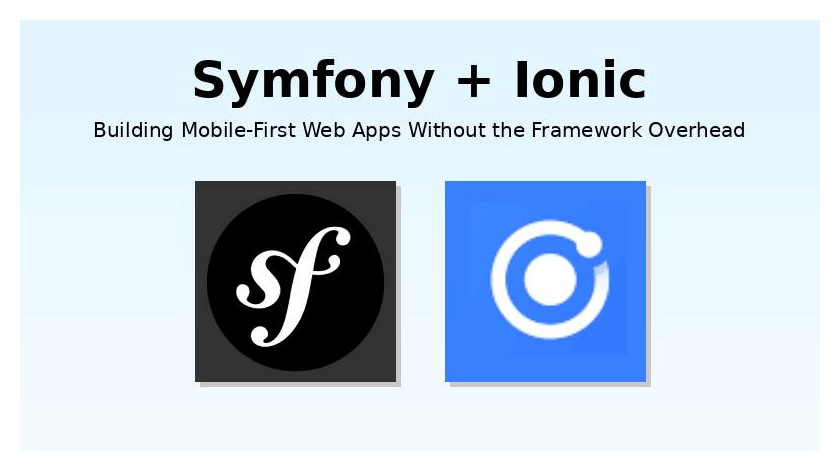Symfony + Ionic: Building Mobile-First Web Apps Without the Framework Overhead
Scrollable Page ...
Introduction
In a recent web app project, I faced the challenge of integrating Ionic UI components into a Symfony-based backend without using a full frontend framework. The goal was to keep the project lightweight while improving mobile user experience. This meant combining Symfony's robust backend capabilities with Ionic's sleek mobile-first components—all rendered through Twig, Symfony's templating engine. Let me walk you through the journey, including the hurdles, solutions, and why this hybrid approach might work for your next project.
What's Symfony?
Symfony is a PHP framework designed for building scalable web applications. Known for its modularity and reusable components, it simplifies complex backend tasks like database management, security, and API development. Symfony works seamlessly with Twig, its powerful templating engine, which allows dynamic content rendering while keeping frontend logic clean. For teams prioritizing structure and maintainability, Symfony is a go-to choice for enterprise-grade backends.
What's Ionic UI Components?
Ionic is a popular toolkit for building responsive, mobile-friendly interfaces. Unlike full frameworks like React or Angular, Ionic focuses on pre-built UI components—buttons, menus, grids—that work across devices. These components mimic native mobile app behavior, making them ideal for projects requiring a mobile-first design without the overhead of a JavaScript framework. Plus, they integrate smoothly with standard HTML, which was crucial for our Twig-based setup.
A Beautiful Meetup: Symfony for Backend, Ionic UI for Frontend
Originally, our project used Symfony with MySQL, Twig, and Bootstrap 5 for the frontend. Designed as a desktop-first internal tool for a Lithuanian company, it relied on Bootstrap's grid for responsiveness. However, mobile users struggled with cluttered tables and endless scrolling. After team discussions, we opted for Ionic's UI components. Why? They offered mobile-optimized elements out of the box, and since we only needed the UI layer—not a full frontend framework—it kept our stack simple and fast.
Ionic UI: A Stubborn Yet Powerful Monster!
Despite experience with Vue and Symfony UX/Stimulus, Ionic's shadow DOM structure threw me off initially. For example, styling components proved tricky.
I spent time trying to change a mere ion-row's background color via different approaches including inline CSS which obviosuly did not work until I
discovered Ionic uses a dedicated color property for styling.
Once I learned its quirks, Ionic became a joy to work with. I joked about this to our CTO ... Ionic is a “stubborn powerful monster”. Once you speak
its language, it's incredibly powerful.
Symfony & Ionic? Sadly, Not Many Resources Out There
The biggest hurdle was integrating Symfony forms with Ionic. We had dozens of forms, and rebuilding them wasn't an option. Symfony's documentation inspired me to create a custom form theme for Ionic, similar to its built-in Bootstrap theme. While time-consuming, this allowed Twig to auto-render Ionic-friendly HTML.
Then came a baffling bug: multi-select EntityType fields returned zero values unless only one option was chosen. No errors in HTML or console—just silent failures. With no existing solutions online, we had two choices: debug for days or disable multi-select on mobile. We chose the latter. This experience highlighted the lack of shared knowledge for Symfony-Ionic integrations. Even AI tools (as of early 2025) couldn't bridge the gap between these two ecosystems.
Conclusion
Combining Symfony and Ionic isn't without challenges, but the payoff is worth it. We achieved a mobile-friendly UI without sacrificing Symfony's backend strengths or overcomplicating the stack. While community resources are scarce, the process taught us to innovate with custom solutions. If your project needs a lightweight, mobile-first frontend paired with a reliable backend, this duo is worth considering—just be ready to tackle a few puzzles along the way.
Let's Collaborate
Need help blending Symfony's backend power with modern UI tools like Ionic? Whether it's form integration, custom themes, or mobile optimization, I'd love to share insights from this project. Let's build something efficient and user-friendly together. Reach out via my contact page to start the conversation!
Keywords:
Symfony backend, Ionic UI components, Twig integration, mobile-first design, Symfony forms, shadow DOM, lightweight web apps, hybrid web development.
By: SurpassAdmin
Posted on March. 7, 2025
Checkout my latest blog post: https://t.co/ntLePa7ipA
— Surpass (@SurpassWD) March 7, 2025